Strategic Management Report of Tesco Plc: Analysis & Recommendations
VerifiedAdded on 2023/06/21
|38
|10237
|133
Report
AI Summary
This report provides a comprehensive strategic analysis of Tesco Plc, a prominent British multinational retailer. It assesses the company's external environment using PESTLE analysis, revealing moderate impacts from political, economic, and social factors, and negative impacts from legal and environmental factors. Porter's Five Forces analysis is employed to understand Tesco's industry position, identifying threats and opportunities. The report delves into Tesco's internal environment, utilizing VRIO analysis to evaluate valuable resources, with a critique of the model's application. The Boston Matrix is used to analyze Tesco's portfolio, highlighting strengths and weaknesses. Financial performance is examined through revenues, profits, margins, and ratios. SWOT analysis integrates findings from PESTLE and Porter's Five Forces. Porter's Generic Strategies and the Ansoff Matrix assess Tesco's business strategies, including rapid expansion and competitive pricing. The report concludes with a TOWS matrix and SAFe model to provide recommendations, emphasizing the need for additional research before expansions and a focus on product differentiation. Desklib is your go-to platform for accessing solved assignments and study resources.
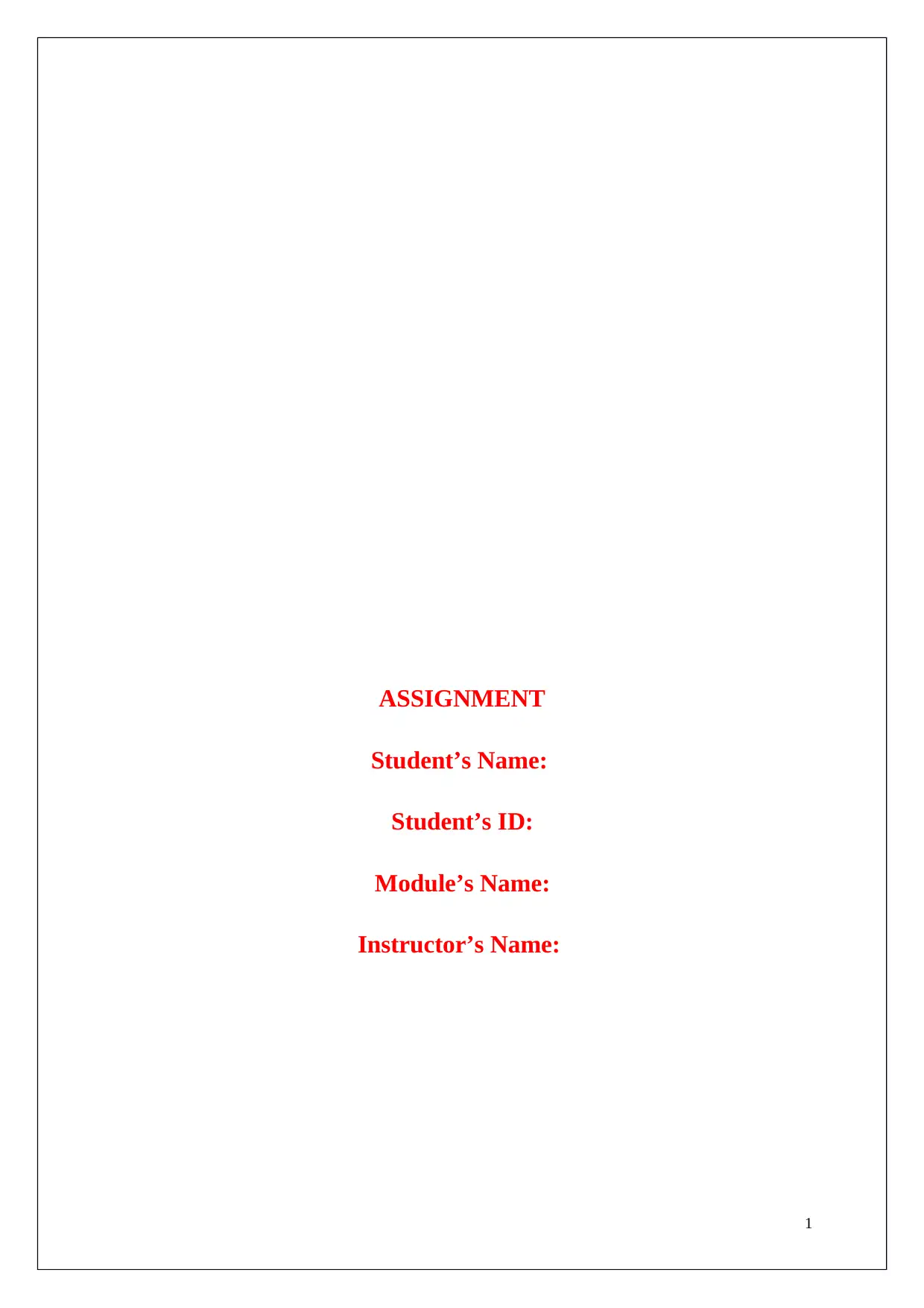
ASSIGNMENT
Student’s Name:
Student’s ID:
Module’s Name:
Instructor’s Name:
1
Student’s Name:
Student’s ID:
Module’s Name:
Instructor’s Name:
1
Paraphrase This Document
Need a fresh take? Get an instant paraphrase of this document with our AI Paraphraser

Executive Summary
In contemporary Business literature, Strategy has been defined as the major tool for replacing
the previous managerial activities of an organisation along with recent measures of
“administration” and “planification”. In addition, this strategic compliance within a business
organisation has therefore included relative measures regarding research and development
areas, technological advances, logistics and supply chain management, human resource
management and managerial approaches as well. Tesco Plc has been a reputed presence
within the British Multinational chain of general merchandise and grocery supplies. Within
the retail market of the UK, Tesco Plc has owned around 4,074 stores and developed a brand
value of 10.7 bn USD.
In order to analyse the external opportunities and threats, a PESTLE analysis has been
conducted. As for the external environment, it has been observed that political, economic and
social factors have left a moderate impact on the organisation. However, the legal and
environmental factors have laid a negative impact on the organisation. On the other hand, for
micro-external analysis, Porter’s Five force analysis has been conducted. This has helped to
analyse its position in the industry and identify the threats and opportunities for strategic
positioning. In addition, the vision and mission of the company has also added value to the
customers to gain advantage.
This report highlights the internal environment of “Tesco” which is important in maintaining
business growth in a highly competitive market. Analysis of the internal environment helps
organizations to find out their strength and weakness which is important for business success.
In the analysis of the internal environment “VRIO” analysis is done to analyze the valuable,
rare amenable and organised resources of the organizations that reflect on the business
performance. Financial structure of Tesco is considered as the most valuable resources of the
organization for their international expansion. Critique of “VRIO” analysis included in the
report.
“Boston Matrix” is adopted for the discussion of the company portfolio. Discussion about
the company portfolio is necessary to maintain business performance. It helps to identify the
strength and weaknesses of the company. Following the steps of “Boston Matrix” is
necessary to build a strong brand portfolio which is important to lead the organization in
proper direction. It also discussed about the four stage of the model which are Dogs, Cash
cow, Stars and Question mark. This report also highlights on the revenues and profits gained
2
In contemporary Business literature, Strategy has been defined as the major tool for replacing
the previous managerial activities of an organisation along with recent measures of
“administration” and “planification”. In addition, this strategic compliance within a business
organisation has therefore included relative measures regarding research and development
areas, technological advances, logistics and supply chain management, human resource
management and managerial approaches as well. Tesco Plc has been a reputed presence
within the British Multinational chain of general merchandise and grocery supplies. Within
the retail market of the UK, Tesco Plc has owned around 4,074 stores and developed a brand
value of 10.7 bn USD.
In order to analyse the external opportunities and threats, a PESTLE analysis has been
conducted. As for the external environment, it has been observed that political, economic and
social factors have left a moderate impact on the organisation. However, the legal and
environmental factors have laid a negative impact on the organisation. On the other hand, for
micro-external analysis, Porter’s Five force analysis has been conducted. This has helped to
analyse its position in the industry and identify the threats and opportunities for strategic
positioning. In addition, the vision and mission of the company has also added value to the
customers to gain advantage.
This report highlights the internal environment of “Tesco” which is important in maintaining
business growth in a highly competitive market. Analysis of the internal environment helps
organizations to find out their strength and weakness which is important for business success.
In the analysis of the internal environment “VRIO” analysis is done to analyze the valuable,
rare amenable and organised resources of the organizations that reflect on the business
performance. Financial structure of Tesco is considered as the most valuable resources of the
organization for their international expansion. Critique of “VRIO” analysis included in the
report.
“Boston Matrix” is adopted for the discussion of the company portfolio. Discussion about
the company portfolio is necessary to maintain business performance. It helps to identify the
strength and weaknesses of the company. Following the steps of “Boston Matrix” is
necessary to build a strong brand portfolio which is important to lead the organization in
proper direction. It also discussed about the four stage of the model which are Dogs, Cash
cow, Stars and Question mark. This report also highlights on the revenues and profits gained
2
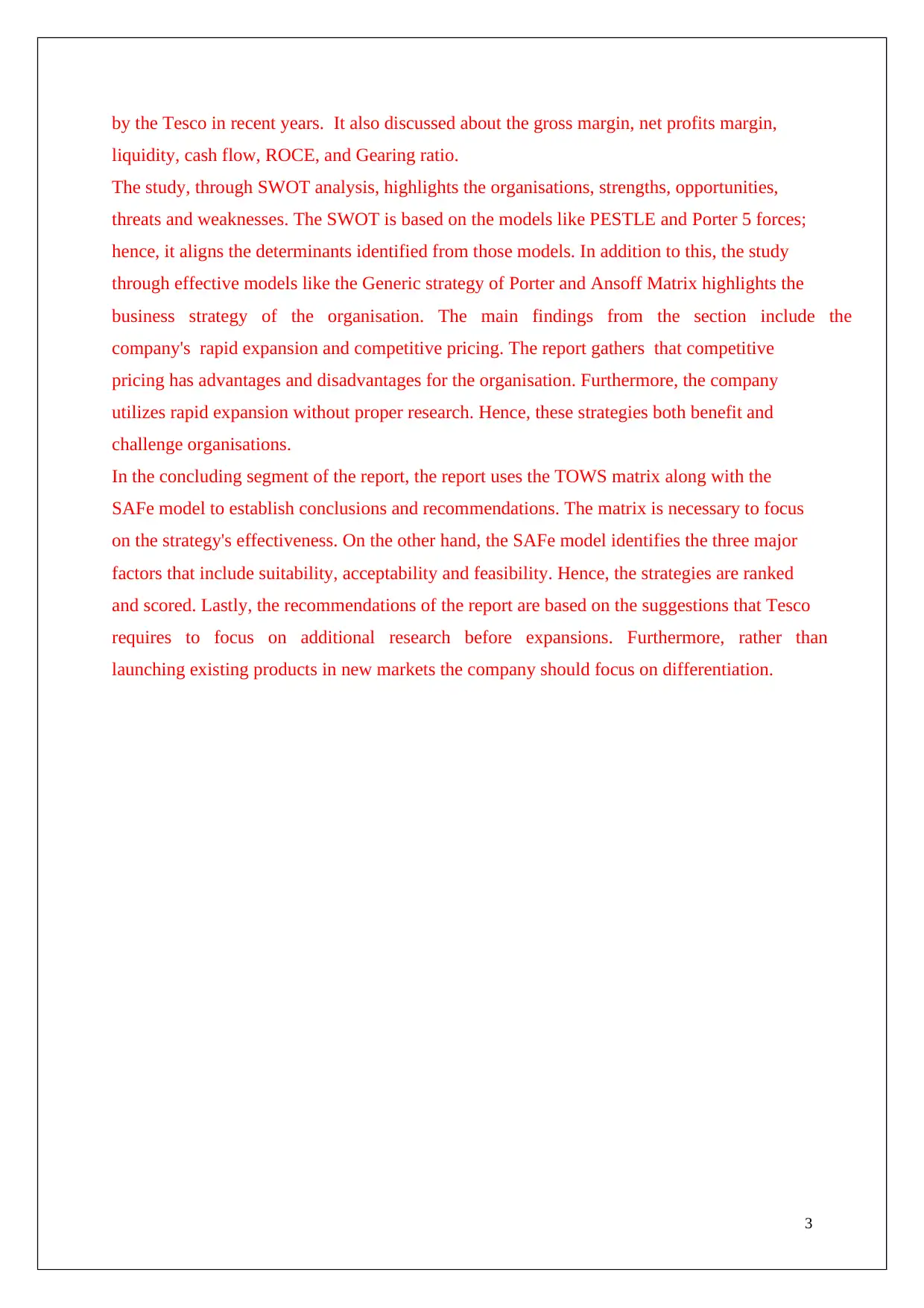
by the Tesco in recent years. It also discussed about the gross margin, net profits margin,
liquidity, cash flow, ROCE, and Gearing ratio.
The study, through SWOT analysis, highlights the organisations, strengths, opportunities,
threats and weaknesses. The SWOT is based on the models like PESTLE and Porter 5 forces;
hence, it aligns the determinants identified from those models. In addition to this, the study
through effective models like the Generic strategy of Porter and Ansoff Matrix highlights the
business strategy of the organisation. The main findings from the section include the
company's rapid expansion and competitive pricing. The report gathers that competitive
pricing has advantages and disadvantages for the organisation. Furthermore, the company
utilizes rapid expansion without proper research. Hence, these strategies both benefit and
challenge organisations.
In the concluding segment of the report, the report uses the TOWS matrix along with the
SAFe model to establish conclusions and recommendations. The matrix is necessary to focus
on the strategy's effectiveness. On the other hand, the SAFe model identifies the three major
factors that include suitability, acceptability and feasibility. Hence, the strategies are ranked
and scored. Lastly, the recommendations of the report are based on the suggestions that Tesco
requires to focus on additional research before expansions. Furthermore, rather than
launching existing products in new markets the company should focus on differentiation.
3
liquidity, cash flow, ROCE, and Gearing ratio.
The study, through SWOT analysis, highlights the organisations, strengths, opportunities,
threats and weaknesses. The SWOT is based on the models like PESTLE and Porter 5 forces;
hence, it aligns the determinants identified from those models. In addition to this, the study
through effective models like the Generic strategy of Porter and Ansoff Matrix highlights the
business strategy of the organisation. The main findings from the section include the
company's rapid expansion and competitive pricing. The report gathers that competitive
pricing has advantages and disadvantages for the organisation. Furthermore, the company
utilizes rapid expansion without proper research. Hence, these strategies both benefit and
challenge organisations.
In the concluding segment of the report, the report uses the TOWS matrix along with the
SAFe model to establish conclusions and recommendations. The matrix is necessary to focus
on the strategy's effectiveness. On the other hand, the SAFe model identifies the three major
factors that include suitability, acceptability and feasibility. Hence, the strategies are ranked
and scored. Lastly, the recommendations of the report are based on the suggestions that Tesco
requires to focus on additional research before expansions. Furthermore, rather than
launching existing products in new markets the company should focus on differentiation.
3
⊘ This is a preview!⊘
Do you want full access?
Subscribe today to unlock all pages.

Trusted by 1+ million students worldwide
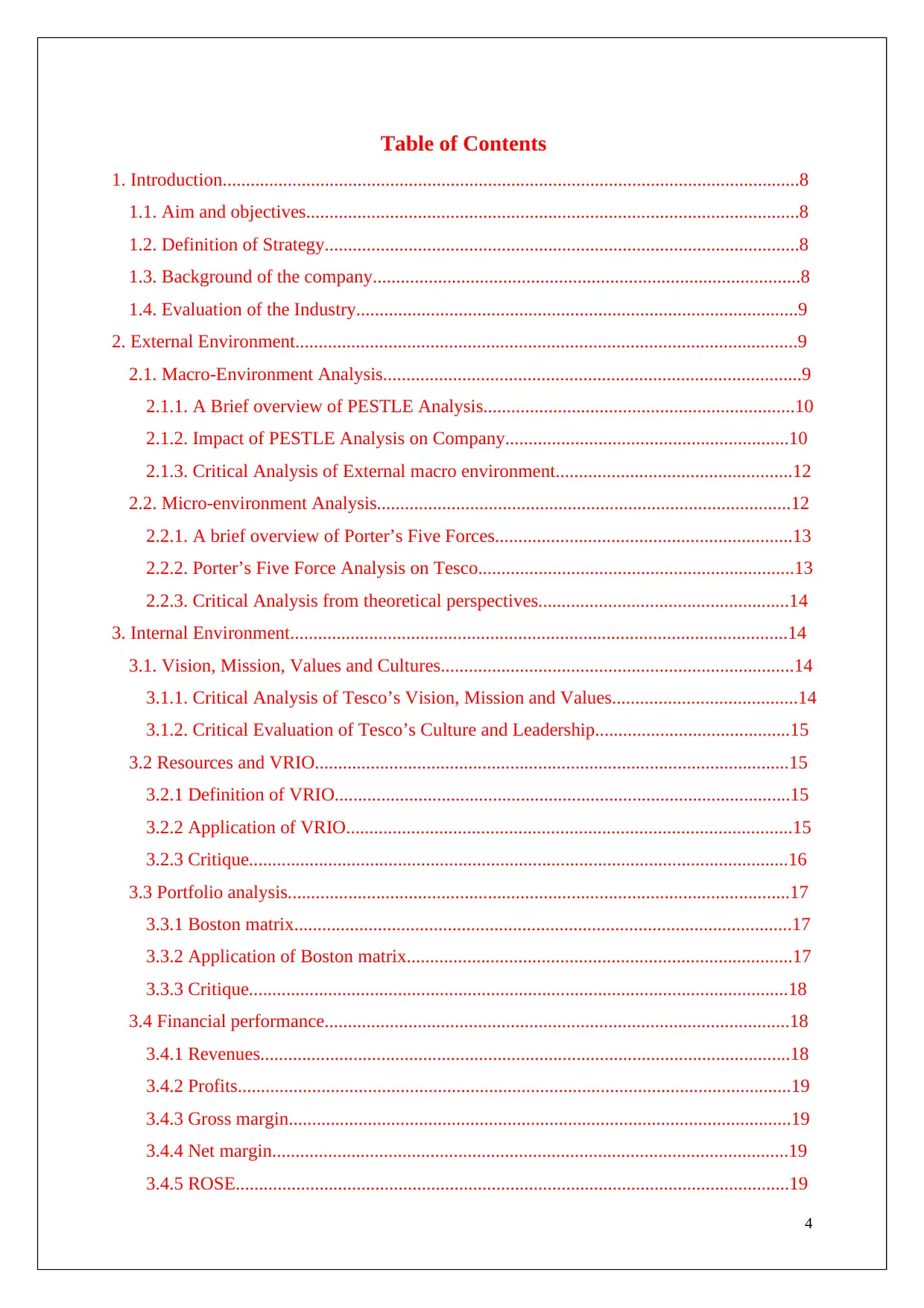
Table of Contents
1. Introduction............................................................................................................................8
1.1. Aim and objectives..........................................................................................................8
1.2. Definition of Strategy......................................................................................................8
1.3. Background of the company............................................................................................8
1.4. Evaluation of the Industry...............................................................................................9
2. External Environment............................................................................................................9
2.1. Macro-Environment Analysis..........................................................................................9
2.1.1. A Brief overview of PESTLE Analysis...................................................................10
2.1.2. Impact of PESTLE Analysis on Company.............................................................10
2.1.3. Critical Analysis of External macro environment...................................................12
2.2. Micro-environment Analysis.........................................................................................12
2.2.1. A brief overview of Porter’s Five Forces................................................................13
2.2.2. Porter’s Five Force Analysis on Tesco....................................................................13
2.2.3. Critical Analysis from theoretical perspectives......................................................14
3. Internal Environment...........................................................................................................14
3.1. Vision, Mission, Values and Cultures............................................................................14
3.1.1. Critical Analysis of Tesco’s Vision, Mission and Values........................................14
3.1.2. Critical Evaluation of Tesco’s Culture and Leadership..........................................15
3.2 Resources and VRIO......................................................................................................15
3.2.1 Definition of VRIO..................................................................................................15
3.2.2 Application of VRIO................................................................................................15
3.2.3 Critique....................................................................................................................16
3.3 Portfolio analysis............................................................................................................17
3.3.1 Boston matrix...........................................................................................................17
3.3.2 Application of Boston matrix...................................................................................17
3.3.3 Critique....................................................................................................................18
3.4 Financial performance....................................................................................................18
3.4.1 Revenues..................................................................................................................18
3.4.2 Profits.......................................................................................................................19
3.4.3 Gross margin............................................................................................................19
3.4.4 Net margin...............................................................................................................19
3.4.5 ROSE.......................................................................................................................19
4
1. Introduction............................................................................................................................8
1.1. Aim and objectives..........................................................................................................8
1.2. Definition of Strategy......................................................................................................8
1.3. Background of the company............................................................................................8
1.4. Evaluation of the Industry...............................................................................................9
2. External Environment............................................................................................................9
2.1. Macro-Environment Analysis..........................................................................................9
2.1.1. A Brief overview of PESTLE Analysis...................................................................10
2.1.2. Impact of PESTLE Analysis on Company.............................................................10
2.1.3. Critical Analysis of External macro environment...................................................12
2.2. Micro-environment Analysis.........................................................................................12
2.2.1. A brief overview of Porter’s Five Forces................................................................13
2.2.2. Porter’s Five Force Analysis on Tesco....................................................................13
2.2.3. Critical Analysis from theoretical perspectives......................................................14
3. Internal Environment...........................................................................................................14
3.1. Vision, Mission, Values and Cultures............................................................................14
3.1.1. Critical Analysis of Tesco’s Vision, Mission and Values........................................14
3.1.2. Critical Evaluation of Tesco’s Culture and Leadership..........................................15
3.2 Resources and VRIO......................................................................................................15
3.2.1 Definition of VRIO..................................................................................................15
3.2.2 Application of VRIO................................................................................................15
3.2.3 Critique....................................................................................................................16
3.3 Portfolio analysis............................................................................................................17
3.3.1 Boston matrix...........................................................................................................17
3.3.2 Application of Boston matrix...................................................................................17
3.3.3 Critique....................................................................................................................18
3.4 Financial performance....................................................................................................18
3.4.1 Revenues..................................................................................................................18
3.4.2 Profits.......................................................................................................................19
3.4.3 Gross margin............................................................................................................19
3.4.4 Net margin...............................................................................................................19
3.4.5 ROSE.......................................................................................................................19
4
Paraphrase This Document
Need a fresh take? Get an instant paraphrase of this document with our AI Paraphraser
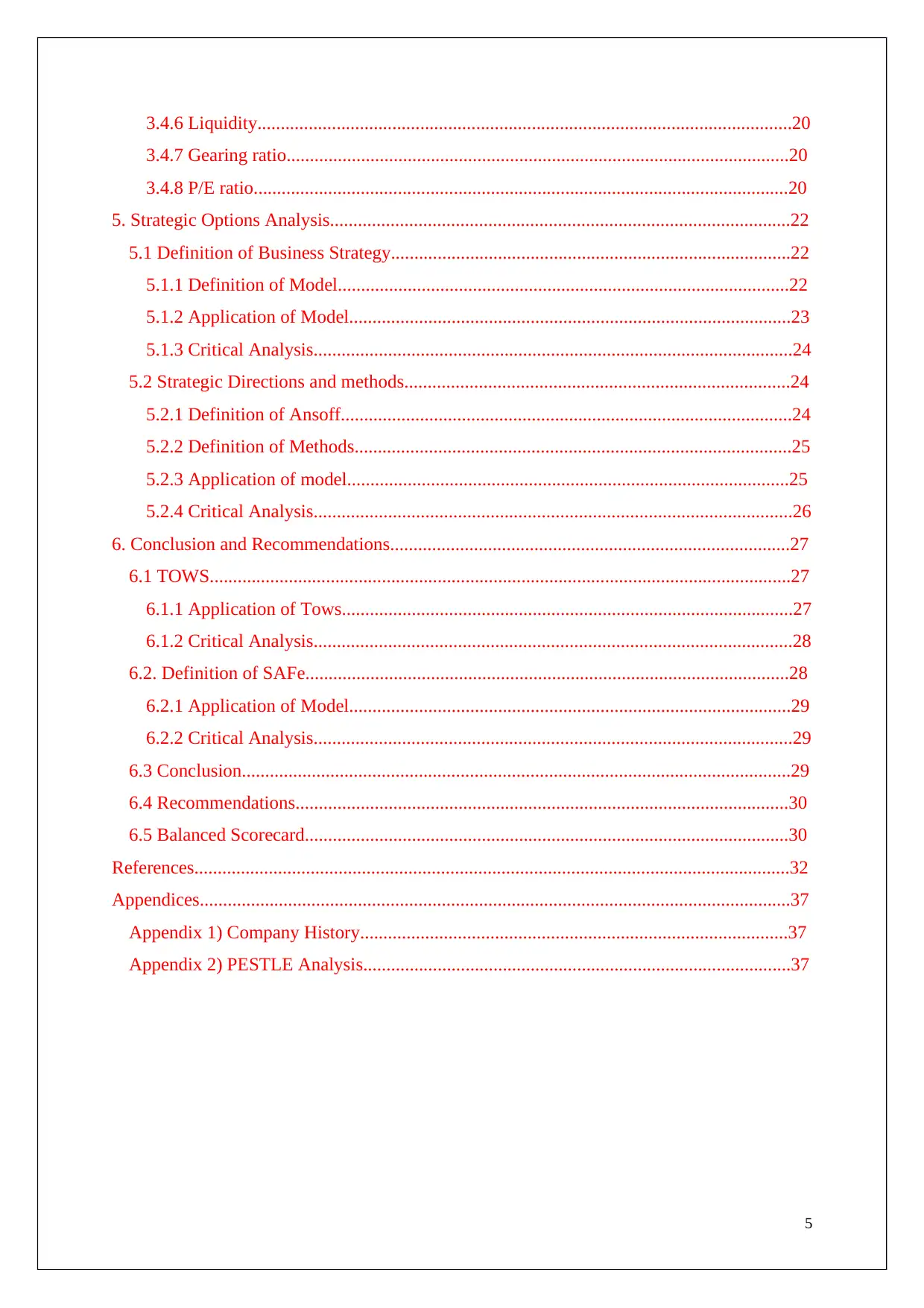
3.4.6 Liquidity...................................................................................................................20
3.4.7 Gearing ratio............................................................................................................20
3.4.8 P/E ratio...................................................................................................................20
5. Strategic Options Analysis...................................................................................................22
5.1 Definition of Business Strategy......................................................................................22
5.1.1 Definition of Model.................................................................................................22
5.1.2 Application of Model...............................................................................................23
5.1.3 Critical Analysis.......................................................................................................24
5.2 Strategic Directions and methods...................................................................................24
5.2.1 Definition of Ansoff.................................................................................................24
5.2.2 Definition of Methods..............................................................................................25
5.2.3 Application of model...............................................................................................25
5.2.4 Critical Analysis.......................................................................................................26
6. Conclusion and Recommendations......................................................................................27
6.1 TOWS.............................................................................................................................27
6.1.1 Application of Tows.................................................................................................27
6.1.2 Critical Analysis.......................................................................................................28
6.2. Definition of SAFe........................................................................................................28
6.2.1 Application of Model...............................................................................................29
6.2.2 Critical Analysis.......................................................................................................29
6.3 Conclusion......................................................................................................................29
6.4 Recommendations..........................................................................................................30
6.5 Balanced Scorecard........................................................................................................30
References................................................................................................................................32
Appendices...............................................................................................................................37
Appendix 1) Company History............................................................................................37
Appendix 2) PESTLE Analysis............................................................................................37
5
3.4.7 Gearing ratio............................................................................................................20
3.4.8 P/E ratio...................................................................................................................20
5. Strategic Options Analysis...................................................................................................22
5.1 Definition of Business Strategy......................................................................................22
5.1.1 Definition of Model.................................................................................................22
5.1.2 Application of Model...............................................................................................23
5.1.3 Critical Analysis.......................................................................................................24
5.2 Strategic Directions and methods...................................................................................24
5.2.1 Definition of Ansoff.................................................................................................24
5.2.2 Definition of Methods..............................................................................................25
5.2.3 Application of model...............................................................................................25
5.2.4 Critical Analysis.......................................................................................................26
6. Conclusion and Recommendations......................................................................................27
6.1 TOWS.............................................................................................................................27
6.1.1 Application of Tows.................................................................................................27
6.1.2 Critical Analysis.......................................................................................................28
6.2. Definition of SAFe........................................................................................................28
6.2.1 Application of Model...............................................................................................29
6.2.2 Critical Analysis.......................................................................................................29
6.3 Conclusion......................................................................................................................29
6.4 Recommendations..........................................................................................................30
6.5 Balanced Scorecard........................................................................................................30
References................................................................................................................................32
Appendices...............................................................................................................................37
Appendix 1) Company History............................................................................................37
Appendix 2) PESTLE Analysis............................................................................................37
5
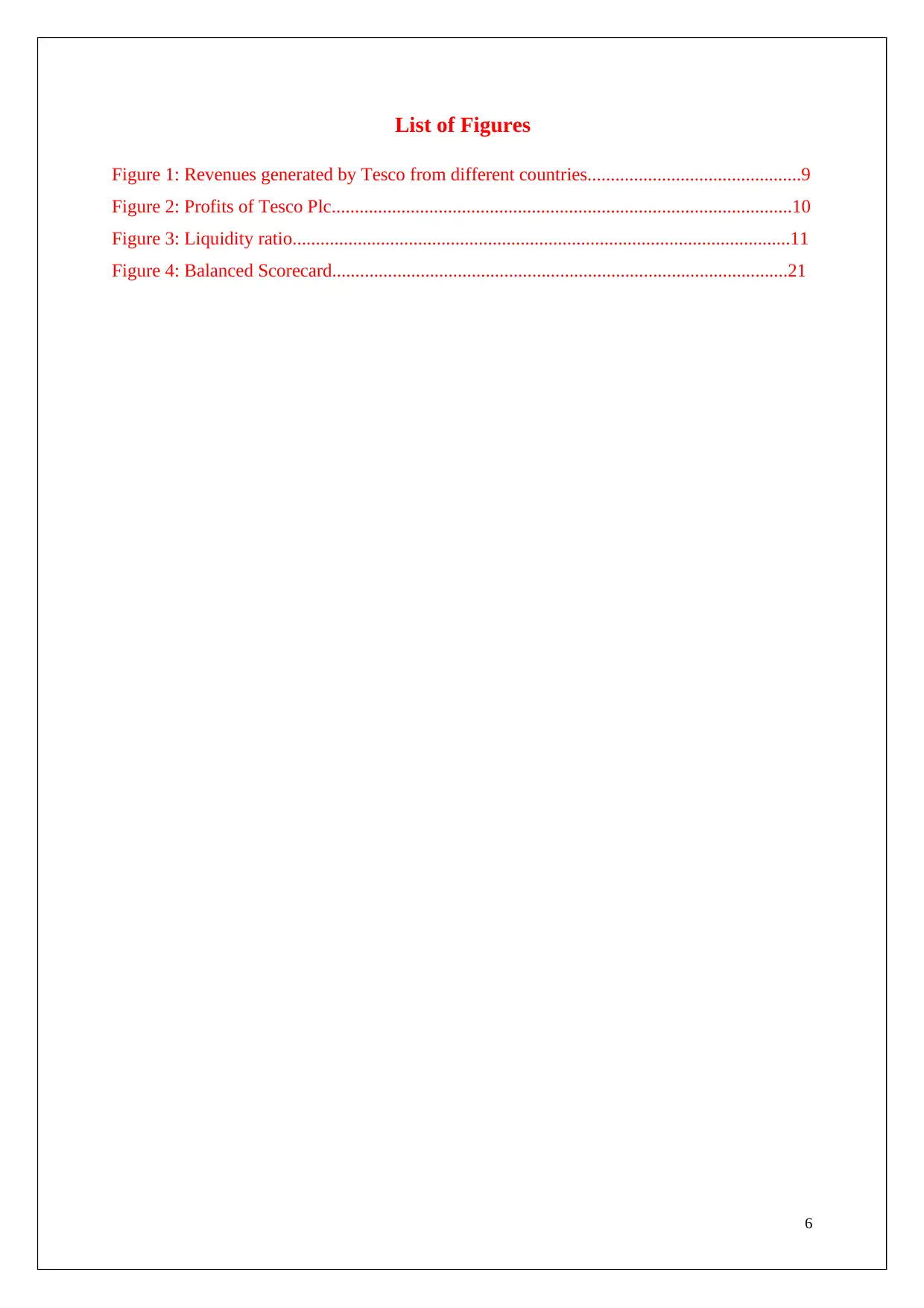
List of Figures
Figure 1: Revenues generated by Tesco from different countries..............................................9
Figure 2: Profits of Tesco Plc...................................................................................................10
Figure 3: Liquidity ratio...........................................................................................................11
Figure 4: Balanced Scorecard..................................................................................................21
6
Figure 1: Revenues generated by Tesco from different countries..............................................9
Figure 2: Profits of Tesco Plc...................................................................................................10
Figure 3: Liquidity ratio...........................................................................................................11
Figure 4: Balanced Scorecard..................................................................................................21
6
⊘ This is a preview!⊘
Do you want full access?
Subscribe today to unlock all pages.

Trusted by 1+ million students worldwide
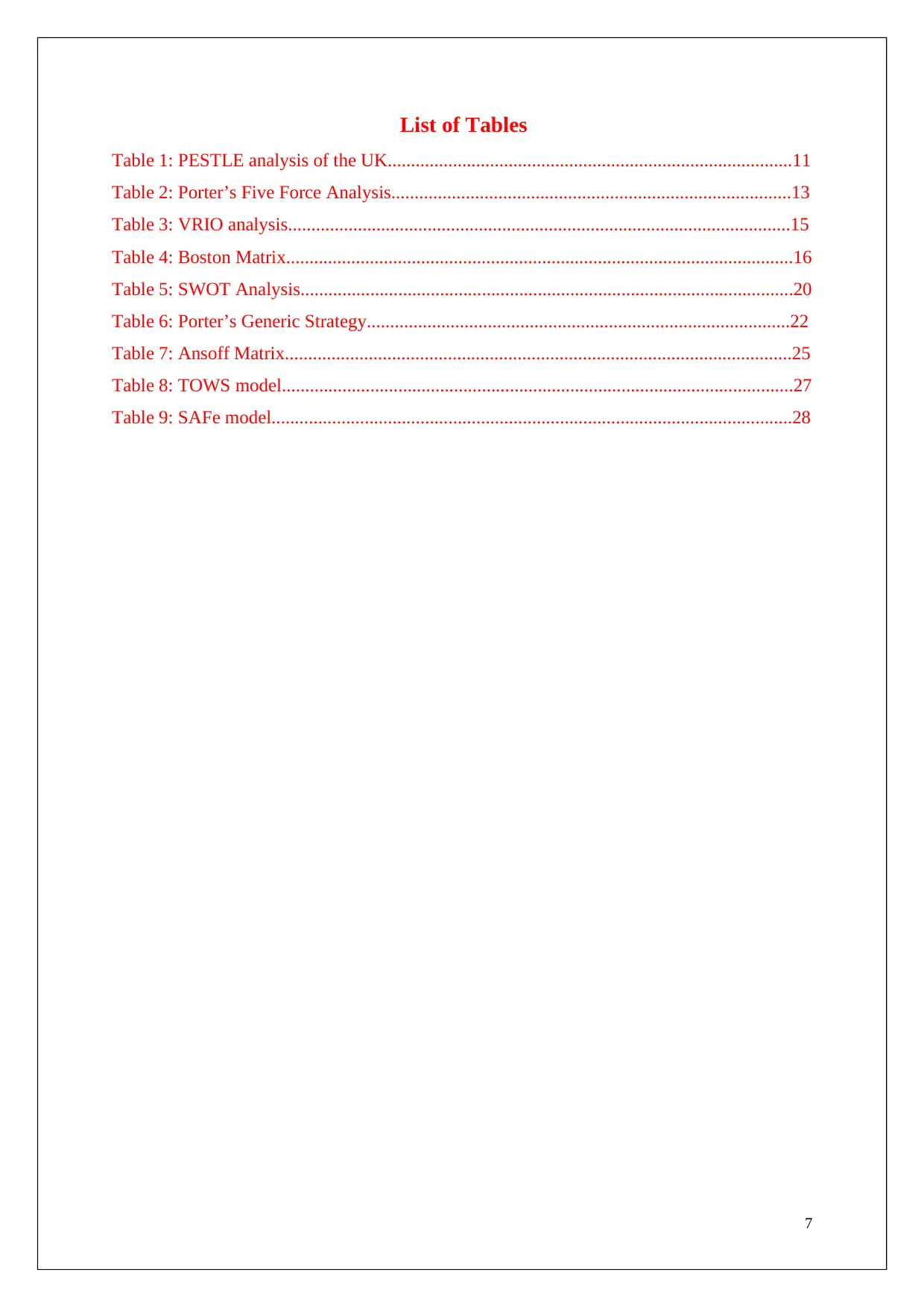
List of Tables
Table 1: PESTLE analysis of the UK.......................................................................................11
Table 2: Porter’s Five Force Analysis......................................................................................13
Table 3: VRIO analysis............................................................................................................15
Table 4: Boston Matrix.............................................................................................................16
Table 5: SWOT Analysis..........................................................................................................20
Table 6: Porter’s Generic Strategy...........................................................................................22
Table 7: Ansoff Matrix.............................................................................................................25
Table 8: TOWS model..............................................................................................................27
Table 9: SAFe model................................................................................................................28
7
Table 1: PESTLE analysis of the UK.......................................................................................11
Table 2: Porter’s Five Force Analysis......................................................................................13
Table 3: VRIO analysis............................................................................................................15
Table 4: Boston Matrix.............................................................................................................16
Table 5: SWOT Analysis..........................................................................................................20
Table 6: Porter’s Generic Strategy...........................................................................................22
Table 7: Ansoff Matrix.............................................................................................................25
Table 8: TOWS model..............................................................................................................27
Table 9: SAFe model................................................................................................................28
7
Paraphrase This Document
Need a fresh take? Get an instant paraphrase of this document with our AI Paraphraser
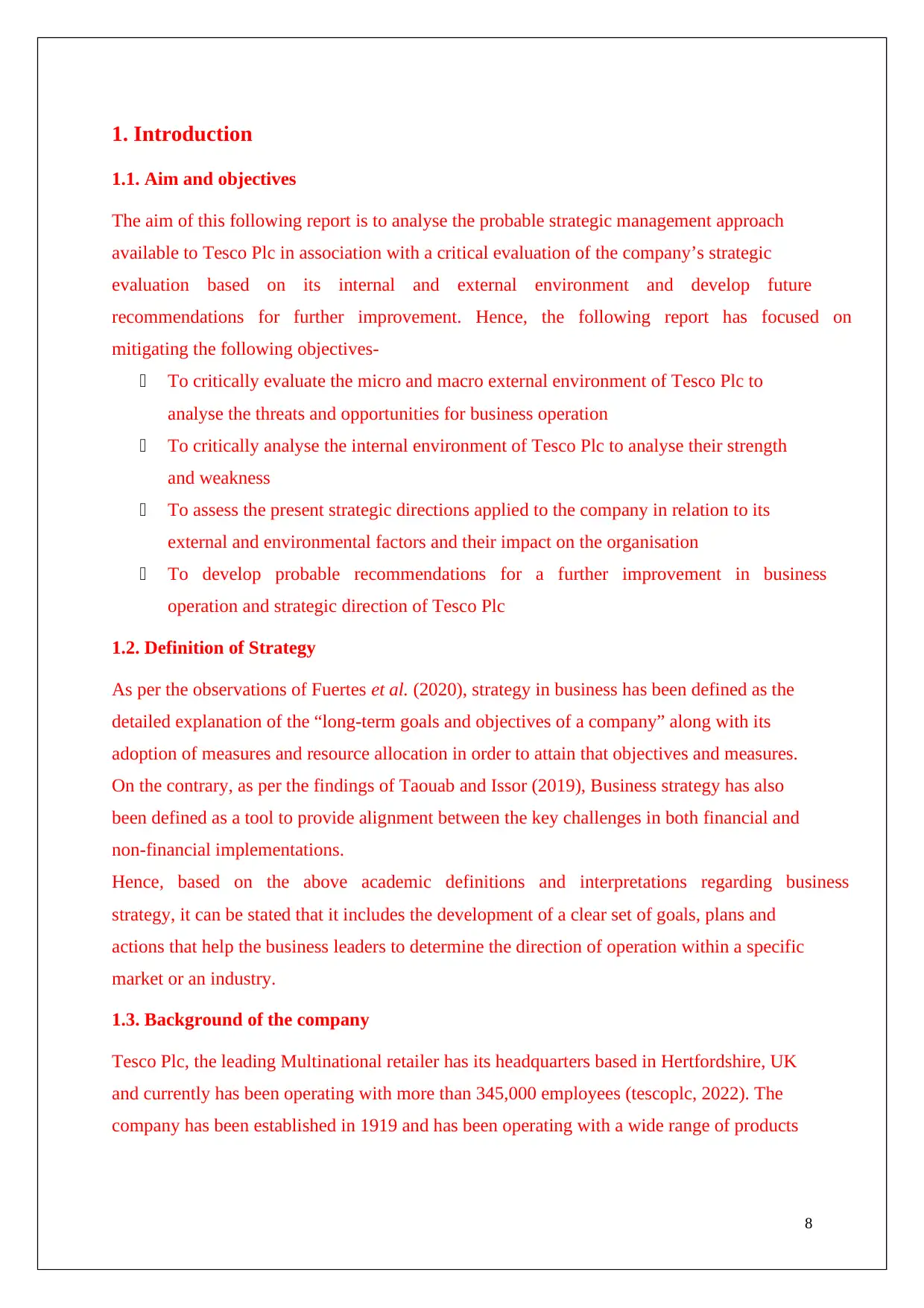
1. Introduction
1.1. Aim and objectives
The aim of this following report is to analyse the probable strategic management approach
available to Tesco Plc in association with a critical evaluation of the company’s strategic
evaluation based on its internal and external environment and develop future
recommendations for further improvement. Hence, the following report has focused on
mitigating the following objectives-
To critically evaluate the micro and macro external environment of Tesco Plc to
analyse the threats and opportunities for business operation
To critically analyse the internal environment of Tesco Plc to analyse their strength
and weakness
To assess the present strategic directions applied to the company in relation to its
external and environmental factors and their impact on the organisation
To develop probable recommendations for a further improvement in business
operation and strategic direction of Tesco Plc
1.2. Definition of Strategy
As per the observations of Fuertes et al. (2020), strategy in business has been defined as the
detailed explanation of the “long-term goals and objectives of a company” along with its
adoption of measures and resource allocation in order to attain that objectives and measures.
On the contrary, as per the findings of Taouab and Issor (2019), Business strategy has also
been defined as a tool to provide alignment between the key challenges in both financial and
non-financial implementations.
Hence, based on the above academic definitions and interpretations regarding business
strategy, it can be stated that it includes the development of a clear set of goals, plans and
actions that help the business leaders to determine the direction of operation within a specific
market or an industry.
1.3. Background of the company
Tesco Plc, the leading Multinational retailer has its headquarters based in Hertfordshire, UK
and currently has been operating with more than 345,000 employees (tescoplc, 2022). The
company has been established in 1919 and has been operating with a wide range of products
8
1.1. Aim and objectives
The aim of this following report is to analyse the probable strategic management approach
available to Tesco Plc in association with a critical evaluation of the company’s strategic
evaluation based on its internal and external environment and develop future
recommendations for further improvement. Hence, the following report has focused on
mitigating the following objectives-
To critically evaluate the micro and macro external environment of Tesco Plc to
analyse the threats and opportunities for business operation
To critically analyse the internal environment of Tesco Plc to analyse their strength
and weakness
To assess the present strategic directions applied to the company in relation to its
external and environmental factors and their impact on the organisation
To develop probable recommendations for a further improvement in business
operation and strategic direction of Tesco Plc
1.2. Definition of Strategy
As per the observations of Fuertes et al. (2020), strategy in business has been defined as the
detailed explanation of the “long-term goals and objectives of a company” along with its
adoption of measures and resource allocation in order to attain that objectives and measures.
On the contrary, as per the findings of Taouab and Issor (2019), Business strategy has also
been defined as a tool to provide alignment between the key challenges in both financial and
non-financial implementations.
Hence, based on the above academic definitions and interpretations regarding business
strategy, it can be stated that it includes the development of a clear set of goals, plans and
actions that help the business leaders to determine the direction of operation within a specific
market or an industry.
1.3. Background of the company
Tesco Plc, the leading Multinational retailer has its headquarters based in Hertfordshire, UK
and currently has been operating with more than 345,000 employees (tescoplc, 2022). The
company has been established in 1919 and has been operating with a wide range of products
8
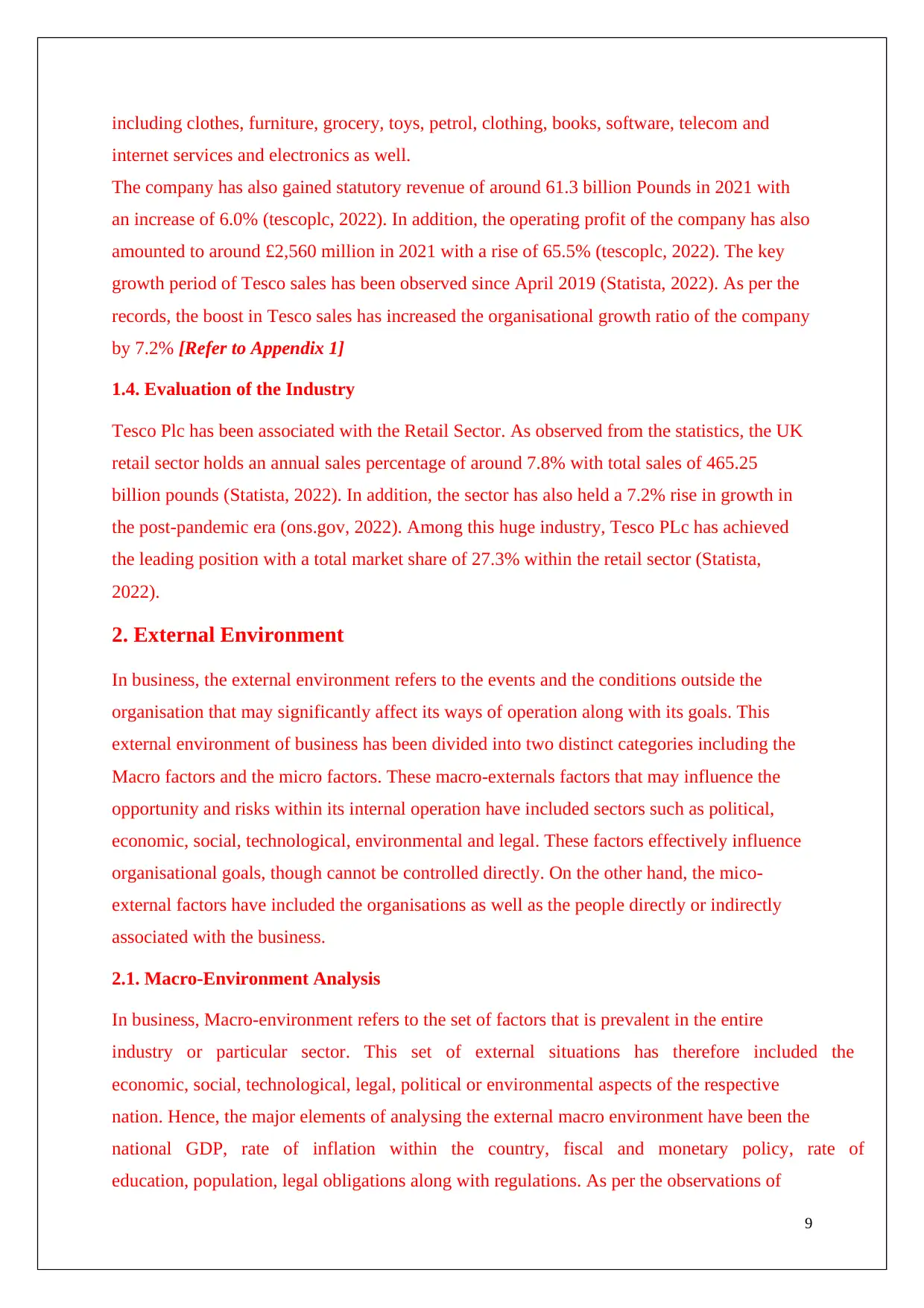
including clothes, furniture, grocery, toys, petrol, clothing, books, software, telecom and
internet services and electronics as well.
The company has also gained statutory revenue of around 61.3 billion Pounds in 2021 with
an increase of 6.0% (tescoplc, 2022). In addition, the operating profit of the company has also
amounted to around £2,560 million in 2021 with a rise of 65.5% (tescoplc, 2022). The key
growth period of Tesco sales has been observed since April 2019 (Statista, 2022). As per the
records, the boost in Tesco sales has increased the organisational growth ratio of the company
by 7.2% [Refer to Appendix 1]
1.4. Evaluation of the Industry
Tesco Plc has been associated with the Retail Sector. As observed from the statistics, the UK
retail sector holds an annual sales percentage of around 7.8% with total sales of 465.25
billion pounds (Statista, 2022). In addition, the sector has also held a 7.2% rise in growth in
the post-pandemic era (ons.gov, 2022). Among this huge industry, Tesco PLc has achieved
the leading position with a total market share of 27.3% within the retail sector (Statista,
2022).
2. External Environment
In business, the external environment refers to the events and the conditions outside the
organisation that may significantly affect its ways of operation along with its goals. This
external environment of business has been divided into two distinct categories including the
Macro factors and the micro factors. These macro-externals factors that may influence the
opportunity and risks within its internal operation have included sectors such as political,
economic, social, technological, environmental and legal. These factors effectively influence
organisational goals, though cannot be controlled directly. On the other hand, the mico-
external factors have included the organisations as well as the people directly or indirectly
associated with the business.
2.1. Macro-Environment Analysis
In business, Macro-environment refers to the set of factors that is prevalent in the entire
industry or particular sector. This set of external situations has therefore included the
economic, social, technological, legal, political or environmental aspects of the respective
nation. Hence, the major elements of analysing the external macro environment have been the
national GDP, rate of inflation within the country, fiscal and monetary policy, rate of
education, population, legal obligations along with regulations. As per the observations of
9
internet services and electronics as well.
The company has also gained statutory revenue of around 61.3 billion Pounds in 2021 with
an increase of 6.0% (tescoplc, 2022). In addition, the operating profit of the company has also
amounted to around £2,560 million in 2021 with a rise of 65.5% (tescoplc, 2022). The key
growth period of Tesco sales has been observed since April 2019 (Statista, 2022). As per the
records, the boost in Tesco sales has increased the organisational growth ratio of the company
by 7.2% [Refer to Appendix 1]
1.4. Evaluation of the Industry
Tesco Plc has been associated with the Retail Sector. As observed from the statistics, the UK
retail sector holds an annual sales percentage of around 7.8% with total sales of 465.25
billion pounds (Statista, 2022). In addition, the sector has also held a 7.2% rise in growth in
the post-pandemic era (ons.gov, 2022). Among this huge industry, Tesco PLc has achieved
the leading position with a total market share of 27.3% within the retail sector (Statista,
2022).
2. External Environment
In business, the external environment refers to the events and the conditions outside the
organisation that may significantly affect its ways of operation along with its goals. This
external environment of business has been divided into two distinct categories including the
Macro factors and the micro factors. These macro-externals factors that may influence the
opportunity and risks within its internal operation have included sectors such as political,
economic, social, technological, environmental and legal. These factors effectively influence
organisational goals, though cannot be controlled directly. On the other hand, the mico-
external factors have included the organisations as well as the people directly or indirectly
associated with the business.
2.1. Macro-Environment Analysis
In business, Macro-environment refers to the set of factors that is prevalent in the entire
industry or particular sector. This set of external situations has therefore included the
economic, social, technological, legal, political or environmental aspects of the respective
nation. Hence, the major elements of analysing the external macro environment have been the
national GDP, rate of inflation within the country, fiscal and monetary policy, rate of
education, population, legal obligations along with regulations. As per the observations of
9
⊘ This is a preview!⊘
Do you want full access?
Subscribe today to unlock all pages.

Trusted by 1+ million students worldwide
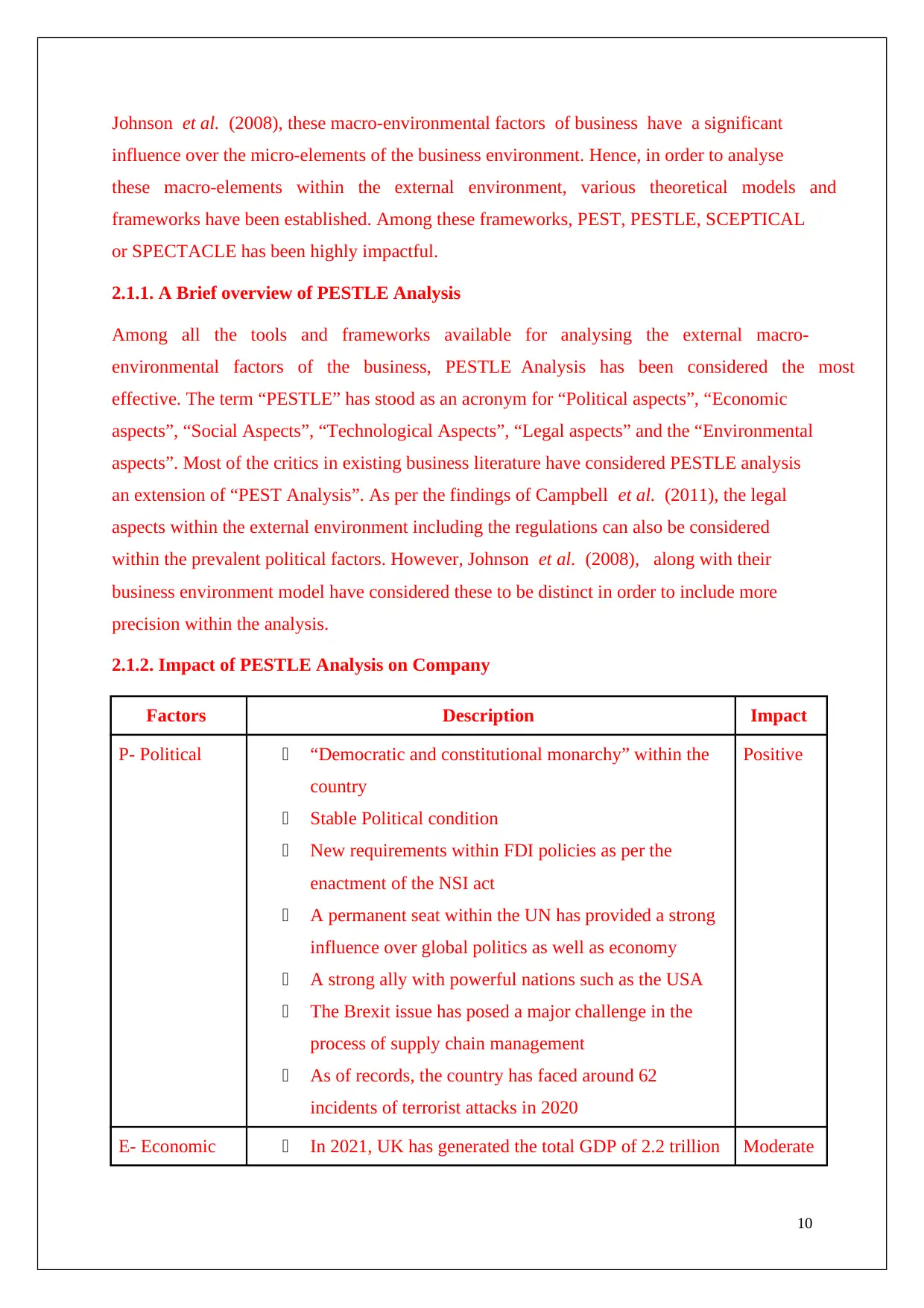
Johnson et al. (2008), these macro-environmental factors of business have a significant
influence over the micro-elements of the business environment. Hence, in order to analyse
these macro-elements within the external environment, various theoretical models and
frameworks have been established. Among these frameworks, PEST, PESTLE, SCEPTICAL
or SPECTACLE has been highly impactful.
2.1.1. A Brief overview of PESTLE Analysis
Among all the tools and frameworks available for analysing the external macro-
environmental factors of the business, PESTLE Analysis has been considered the most
effective. The term “PESTLE” has stood as an acronym for “Political aspects”, “Economic
aspects”, “Social Aspects”, “Technological Aspects”, “Legal aspects” and the “Environmental
aspects”. Most of the critics in existing business literature have considered PESTLE analysis
an extension of “PEST Analysis”. As per the findings of Campbell et al. (2011), the legal
aspects within the external environment including the regulations can also be considered
within the prevalent political factors. However, Johnson et al. (2008), along with their
business environment model have considered these to be distinct in order to include more
precision within the analysis.
2.1.2. Impact of PESTLE Analysis on Company
Factors Description Impact
P- Political “Democratic and constitutional monarchy” within the
country
Stable Political condition
New requirements within FDI policies as per the
enactment of the NSI act
A permanent seat within the UN has provided a strong
influence over global politics as well as economy
A strong ally with powerful nations such as the USA
The Brexit issue has posed a major challenge in the
process of supply chain management
As of records, the country has faced around 62
incidents of terrorist attacks in 2020
Positive
E- Economic In 2021, UK has generated the total GDP of 2.2 trillion Moderate
10
influence over the micro-elements of the business environment. Hence, in order to analyse
these macro-elements within the external environment, various theoretical models and
frameworks have been established. Among these frameworks, PEST, PESTLE, SCEPTICAL
or SPECTACLE has been highly impactful.
2.1.1. A Brief overview of PESTLE Analysis
Among all the tools and frameworks available for analysing the external macro-
environmental factors of the business, PESTLE Analysis has been considered the most
effective. The term “PESTLE” has stood as an acronym for “Political aspects”, “Economic
aspects”, “Social Aspects”, “Technological Aspects”, “Legal aspects” and the “Environmental
aspects”. Most of the critics in existing business literature have considered PESTLE analysis
an extension of “PEST Analysis”. As per the findings of Campbell et al. (2011), the legal
aspects within the external environment including the regulations can also be considered
within the prevalent political factors. However, Johnson et al. (2008), along with their
business environment model have considered these to be distinct in order to include more
precision within the analysis.
2.1.2. Impact of PESTLE Analysis on Company
Factors Description Impact
P- Political “Democratic and constitutional monarchy” within the
country
Stable Political condition
New requirements within FDI policies as per the
enactment of the NSI act
A permanent seat within the UN has provided a strong
influence over global politics as well as economy
A strong ally with powerful nations such as the USA
The Brexit issue has posed a major challenge in the
process of supply chain management
As of records, the country has faced around 62
incidents of terrorist attacks in 2020
Positive
E- Economic In 2021, UK has generated the total GDP of 2.2 trillion Moderate
10
Paraphrase This Document
Need a fresh take? Get an instant paraphrase of this document with our AI Paraphraser
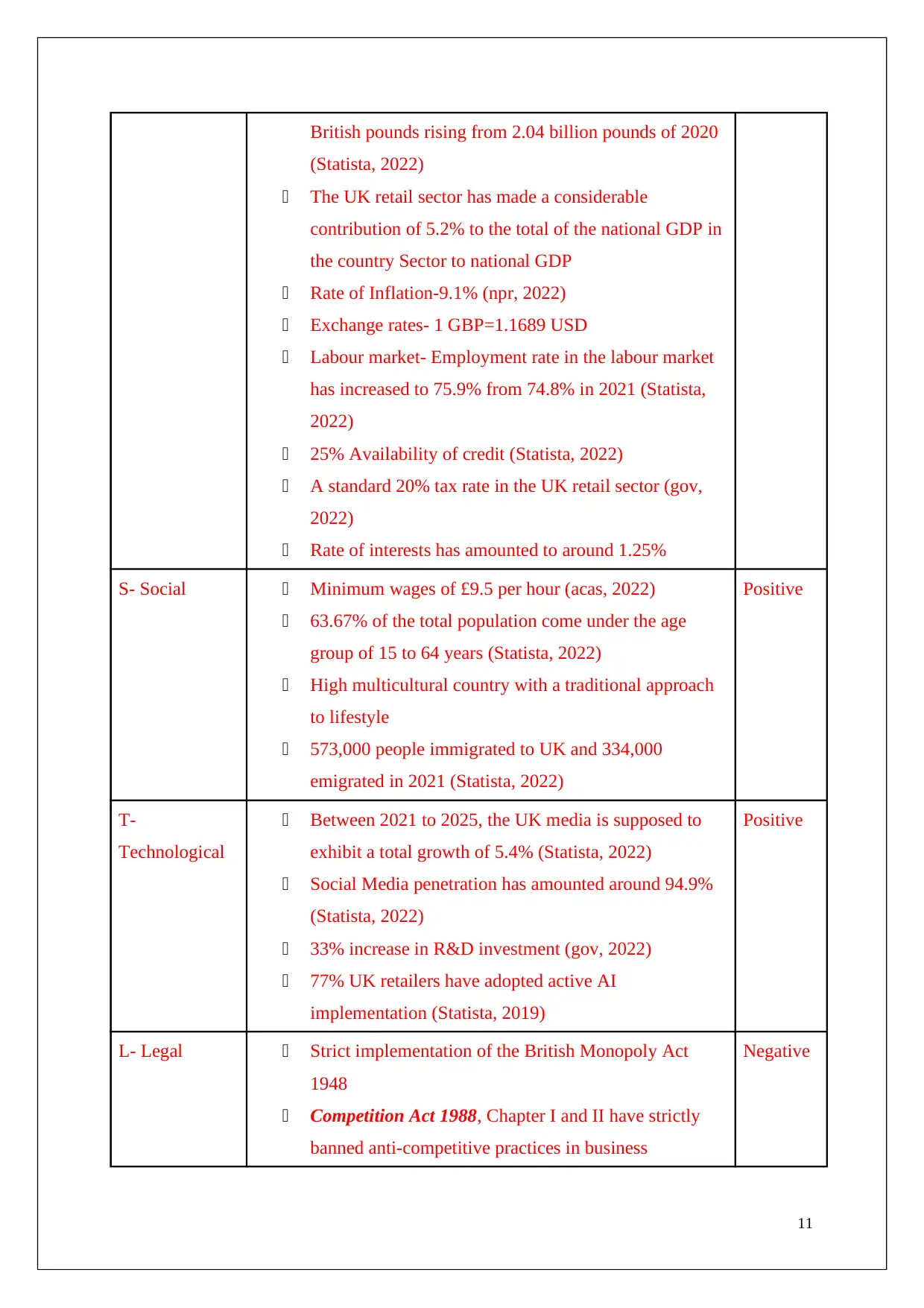
British pounds rising from 2.04 billion pounds of 2020
(Statista, 2022)
The UK retail sector has made a considerable
contribution of 5.2% to the total of the national GDP in
the country Sector to national GDP
Rate of Inflation-9.1% (npr, 2022)
Exchange rates- 1 GBP=1.1689 USD
Labour market- Employment rate in the labour market
has increased to 75.9% from 74.8% in 2021 (Statista,
2022)
25% Availability of credit (Statista, 2022)
A standard 20% tax rate in the UK retail sector (gov,
2022)
Rate of interests has amounted to around 1.25%
S- Social Minimum wages of £9.5 per hour (acas, 2022)
63.67% of the total population come under the age
group of 15 to 64 years (Statista, 2022)
High multicultural country with a traditional approach
to lifestyle
573,000 people immigrated to UK and 334,000
emigrated in 2021 (Statista, 2022)
Positive
T-
Technological
Between 2021 to 2025, the UK media is supposed to
exhibit a total growth of 5.4% (Statista, 2022)
Social Media penetration has amounted around 94.9%
(Statista, 2022)
33% increase in R&D investment (gov, 2022)
77% UK retailers have adopted active AI
implementation (Statista, 2019)
Positive
L- Legal Strict implementation of the British Monopoly Act
1948
Competition Act 1988, Chapter I and II have strictly
banned anti-competitive practices in business
Negative
11
(Statista, 2022)
The UK retail sector has made a considerable
contribution of 5.2% to the total of the national GDP in
the country Sector to national GDP
Rate of Inflation-9.1% (npr, 2022)
Exchange rates- 1 GBP=1.1689 USD
Labour market- Employment rate in the labour market
has increased to 75.9% from 74.8% in 2021 (Statista,
2022)
25% Availability of credit (Statista, 2022)
A standard 20% tax rate in the UK retail sector (gov,
2022)
Rate of interests has amounted to around 1.25%
S- Social Minimum wages of £9.5 per hour (acas, 2022)
63.67% of the total population come under the age
group of 15 to 64 years (Statista, 2022)
High multicultural country with a traditional approach
to lifestyle
573,000 people immigrated to UK and 334,000
emigrated in 2021 (Statista, 2022)
Positive
T-
Technological
Between 2021 to 2025, the UK media is supposed to
exhibit a total growth of 5.4% (Statista, 2022)
Social Media penetration has amounted around 94.9%
(Statista, 2022)
33% increase in R&D investment (gov, 2022)
77% UK retailers have adopted active AI
implementation (Statista, 2019)
Positive
L- Legal Strict implementation of the British Monopoly Act
1948
Competition Act 1988, Chapter I and II have strictly
banned anti-competitive practices in business
Negative
11
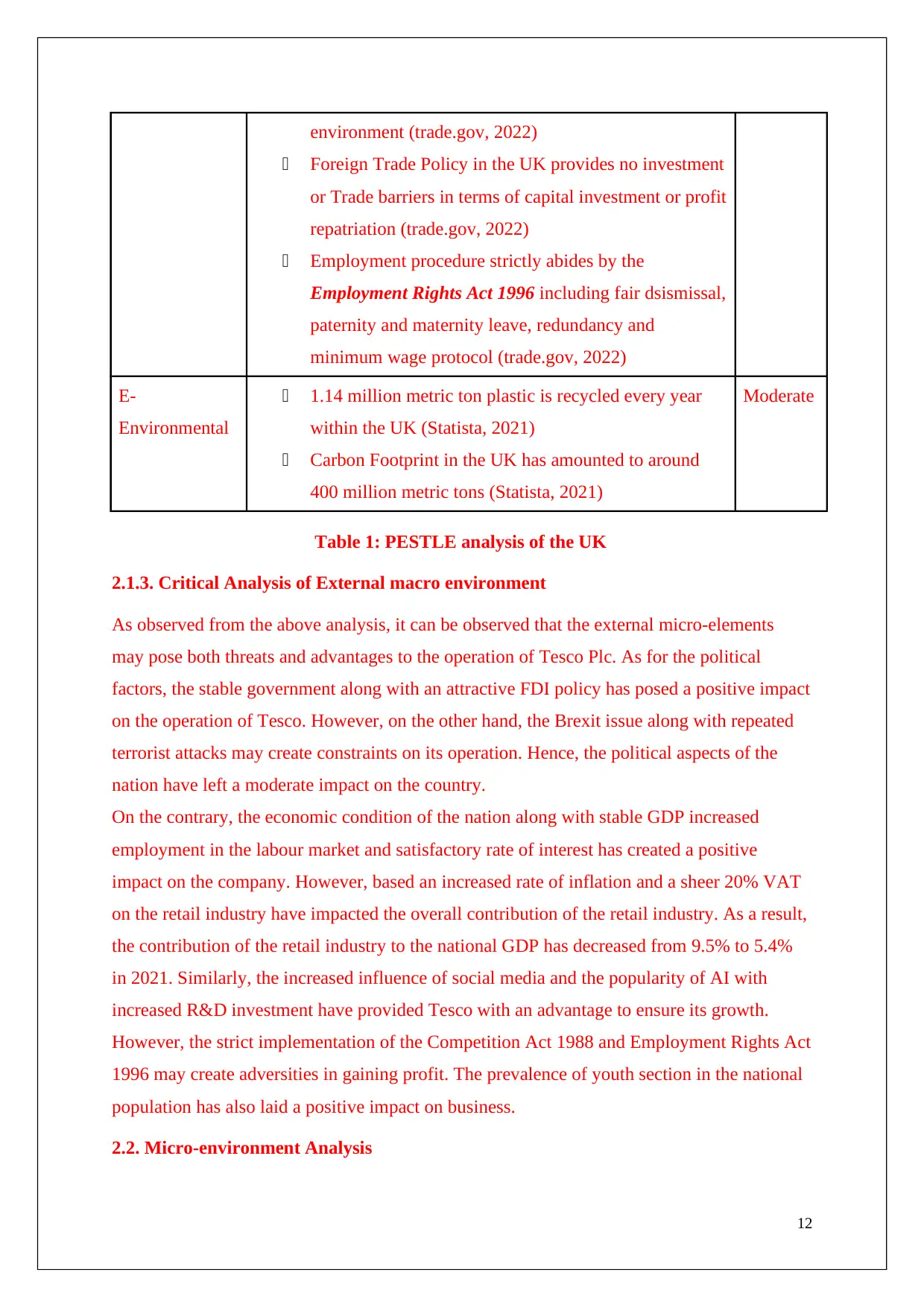
environment (trade.gov, 2022)
Foreign Trade Policy in the UK provides no investment
or Trade barriers in terms of capital investment or profit
repatriation (trade.gov, 2022)
Employment procedure strictly abides by the
Employment Rights Act 1996 including fair dsismissal,
paternity and maternity leave, redundancy and
minimum wage protocol (trade.gov, 2022)
E-
Environmental
1.14 million metric ton plastic is recycled every year
within the UK (Statista, 2021)
Carbon Footprint in the UK has amounted to around
400 million metric tons (Statista, 2021)
Moderate
Table 1: PESTLE analysis of the UK
2.1.3. Critical Analysis of External macro environment
As observed from the above analysis, it can be observed that the external micro-elements
may pose both threats and advantages to the operation of Tesco Plc. As for the political
factors, the stable government along with an attractive FDI policy has posed a positive impact
on the operation of Tesco. However, on the other hand, the Brexit issue along with repeated
terrorist attacks may create constraints on its operation. Hence, the political aspects of the
nation have left a moderate impact on the country.
On the contrary, the economic condition of the nation along with stable GDP increased
employment in the labour market and satisfactory rate of interest has created a positive
impact on the company. However, based an increased rate of inflation and a sheer 20% VAT
on the retail industry have impacted the overall contribution of the retail industry. As a result,
the contribution of the retail industry to the national GDP has decreased from 9.5% to 5.4%
in 2021. Similarly, the increased influence of social media and the popularity of AI with
increased R&D investment have provided Tesco with an advantage to ensure its growth.
However, the strict implementation of the Competition Act 1988 and Employment Rights Act
1996 may create adversities in gaining profit. The prevalence of youth section in the national
population has also laid a positive impact on business.
2.2. Micro-environment Analysis
12
Foreign Trade Policy in the UK provides no investment
or Trade barriers in terms of capital investment or profit
repatriation (trade.gov, 2022)
Employment procedure strictly abides by the
Employment Rights Act 1996 including fair dsismissal,
paternity and maternity leave, redundancy and
minimum wage protocol (trade.gov, 2022)
E-
Environmental
1.14 million metric ton plastic is recycled every year
within the UK (Statista, 2021)
Carbon Footprint in the UK has amounted to around
400 million metric tons (Statista, 2021)
Moderate
Table 1: PESTLE analysis of the UK
2.1.3. Critical Analysis of External macro environment
As observed from the above analysis, it can be observed that the external micro-elements
may pose both threats and advantages to the operation of Tesco Plc. As for the political
factors, the stable government along with an attractive FDI policy has posed a positive impact
on the operation of Tesco. However, on the other hand, the Brexit issue along with repeated
terrorist attacks may create constraints on its operation. Hence, the political aspects of the
nation have left a moderate impact on the country.
On the contrary, the economic condition of the nation along with stable GDP increased
employment in the labour market and satisfactory rate of interest has created a positive
impact on the company. However, based an increased rate of inflation and a sheer 20% VAT
on the retail industry have impacted the overall contribution of the retail industry. As a result,
the contribution of the retail industry to the national GDP has decreased from 9.5% to 5.4%
in 2021. Similarly, the increased influence of social media and the popularity of AI with
increased R&D investment have provided Tesco with an advantage to ensure its growth.
However, the strict implementation of the Competition Act 1988 and Employment Rights Act
1996 may create adversities in gaining profit. The prevalence of youth section in the national
population has also laid a positive impact on business.
2.2. Micro-environment Analysis
12
⊘ This is a preview!⊘
Do you want full access?
Subscribe today to unlock all pages.

Trusted by 1+ million students worldwide
1 out of 38
Related Documents
Your All-in-One AI-Powered Toolkit for Academic Success.
+13062052269
info@desklib.com
Available 24*7 on WhatsApp / Email
![[object Object]](/_next/static/media/star-bottom.7253800d.svg)
Unlock your academic potential
Copyright © 2020–2025 A2Z Services. All Rights Reserved. Developed and managed by ZUCOL.





